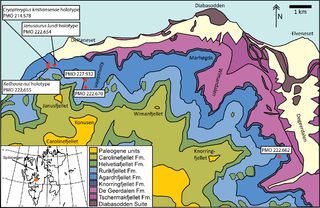 W
WThe geology of Svalbard encompasses the geological description of rock types found in Svalbard, and the associated tectonics and sedimentological history of soils and rocks. The geological exploration of Svalbard is an ongoing activity, and recent understandings may differ from earlier interpretations.
 W
WThe Agardhfjellet Formation is a geologic formation in Svalbard, Norway. It preserves fossils dating back to the Tithonian to Berriasian stages, spanning the Late Jurassic-Early Cretaceous boundary. The formation contains the Slottsmøya Member, a highly fossiliferous unit (Lagerstätte) where many ichthyosaur, plesiosaur and pliosaur fossils have been found.
 W
WBarents Sea dike swarm consists of two groups of dolerite dikes across the Svalbard and Franz Josef Land regions. The emplacement of dikes was associated with the Cretaceous High Arctic Large Igneous Province (HALIP).
 W
WThe Festningen Sandstone is an Early Cretaceous (Barremian) geologic formation in Svalbard, in the far north of Norway. Fossil ornithopod tracks have been reported from the formation.
 W
WThe Kapp Toscana Group is a geologic group in Svalbard and Jan Mayen in the Barents Sea, Norway.
 W
WThe Sassendalen Group is a geologic group in Svalbard, Norway. The marine to deltaic mudstones, siltstones and sandstones preserve fossils dating back to the Early Triassic period.
 W
WThe Tschermakfjellet Formation is a geological formation in Svalbard, Norway, a subunit of the Kapp Toscana Group. The formation dates to the Late Triassic.
 W
WThe Twillingodden Formation is a geologic formation in Svalbard, Norway. It preserves fossils dating back to the Smithian period.
 W
WThe Vardebukta Formation is a geologic formation in Norway. It preserves fossils dating back to the Early Triassic (Dienerian) period.
 W
WThe Vikinghøgda Formation is a geologic formation in Svalbard, Norway. It preserves fossils dating back to the Early Triassic (Griesbachian-Smithian) period.
 W
WThe Wilhelmøya Formation is a geologic formation in Svalbard, Norway. The marginal marine; concretionary, sideritic sandstones preserve indeterminate ichthyosaur and plesiosaur fossils dating back to the Rhaetian period.